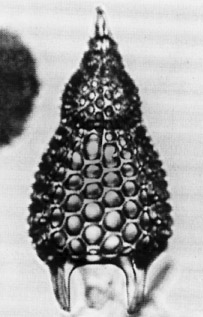 Podocyrtis
(Lampterium) trachodes Riedel and Sanfilippo
Podocyrtis
(Lampterium) trachodes Riedel and Sanfilippo Podocyrtis
(Lampterium) trachodes Riedel and Sanfilippo
Podocyrtis
(Lampterium) trachodes Riedel and SanfilippoPodocyrtis (Lampterium) trachodes Riedel and Sanfilippo, 1970, p.535, pl.11, fig.7, pl.12, fig.1
Cephalis [three-lobed], hemispherical, with many small pores, bearing a three-bladed horn of about the same length. Thorax campanulate and abdomen moderately inflated, broadest at about its middle; both segments thick-walled with rough surface and with subcircular pores, larger in abdomen than in thorax, in indistinct longitudinal rows. Collar and lumbar strictures moderately distinct. Three feet short and flat, spathulate or triangular. In occasional specimens, feet are absent (Riedel and Sanfilippo, 1970).
Thorax 45-70 µm long; 85-100 µm wide; abdomen 135-230 µm long (including feet) 135-185 µm wide (Riedel and Sanfilippo, 1970).
The general form usually resembles that of P. (L.) mitra, from which P. (L.) trachodes is distinguished by the rough surface [and knobby outline] of the abdomen. Specimens with a short abdomen and poorly developed feet differ from P. (L.) fasciolata by having neither the thickened peristome nor longitudinally aligned thoracic pores (Sanfilippo et al., 1985).
The surface of the abdomen is always rough, but the thorax is smooth in early specimens and rough in late ones. When the abdomen is short it is widest medially, and when long it tends to be widest distally. Spathulate feet are normally well developed, rarely vestigial (Sanfilippo et al., 1985).
This middle middle Eocene species is only found in assemblages from low latitudes. Its morphotypic first appearance lies within the Podocyrtis ampla Zone. Its morphotypic last appearance lies within the Podocyrtis chalara Zone.
This species is evidently an offshoot from the main Podocyrtis (Lampterium) lineage, at about the level of transition from P. (L.) sinuosa to P. (L.) mitra. It left no known descendants.